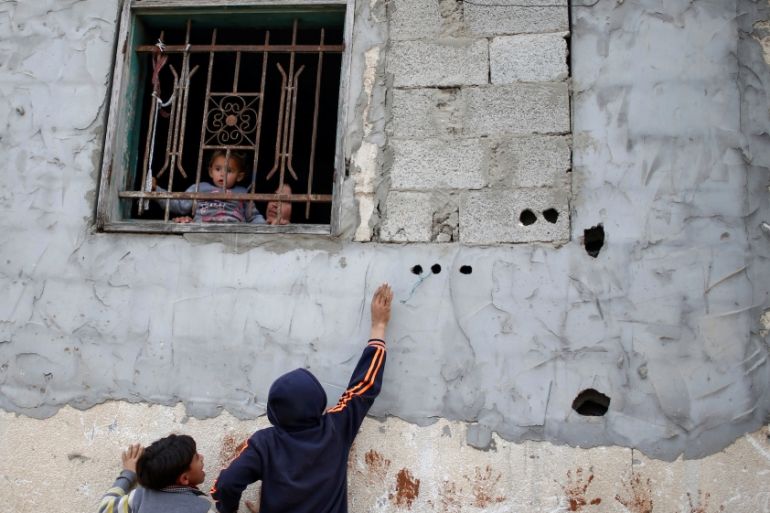The story of Gaza is a story of neglect
Gaza’s economy has collapsed but its residents cannot do anything about it.

Humanitarian, socioeconomic, political and security conditions in Gaza are inexorably worsening. The great majority of Gaza’s two million inhabitants are trapped in a cycle of violence, poverty and pervasive vulnerability created by policies and political decisions.
Breaking this vicious cycle is a human rights imperative and a global responsibility.
Keep reading
list of 4 items‘I blame the government’: Poor Kenyans say no support amid record flooding
‘We need you’: Solomon Islands’ support for US agency’s return revealed
‘Triple spending’: Zimbabweans bear cost of changing to new ZiG currency
As result of the ongoing blockade, three devastating military operations, and an intra-Palestinian divide, the development trajectory of Gaza has been significantly halted in recent years. This caused the already beleaguered coastal strip’s economy to collapse and brought about even more vulnerability and human anguish.
The myriad of problems and complications currently affecting Gaza are overwhelming and disorienting even for people most adept at dealing with countries in crisis. Today, women, men, children and the elderly of Gaza are all forced to survive on a water supply that is 95 percent contaminated. They are also forced to live without electricity for 20 hours a day. And the world, seemingly accustomed to the suffering of the marginalised, turns a blind eye.
Gaza residents are living in a wide web of mutually reinforcing adversities. Gaza’s economic growth dropped from eight percent in 2016 to a mere 0.5 percent in 2017, with almost half of the labour force unemployed. This ranks Gaza, if extrapolated as a country, as experiencing the second-greatest decrease of gross domestic product (GDP) in 2017 compared with the previous year, worldwide, second only to Venezuela.
Gaza’s agriculture, manufacturing, trade and construction sectors shrank to unprecedented levels. Today Gaza’s economy is much more reliant on consumer spending and international financial assistance than ever before.
|
|
The liquidity squeeze and the increases in credit spending and debt also add to Gaza’s economic blues. This is a deeply flawed economic model not created by Palestinians in Gaza themselves, but enforced by Israel’s blockade.
The United Nations Development Programme (UNDP) in the State of Palestine recently conducted a household-level public perception survey in Gaza. As much as 92 percent of respondents expressed that they have personal anxiety related to the overall economic conditions and 87 percent said the ongoing political and civil unrest is likely owing to the poor economic climate.
The fragility of Gaza’s household economy is illustrated in the rising unemployment rates and a sharp increase in poverty rates – from 39 percent in 2011 to 53 percent in 2017 – as well as a significant increase in deep poverty.
Full-time work is rare in Gaza. Only one-fifth of our survey’s respondents said they are holding full-time jobs. A few more said they are working part-time. Nearly 40 percent of the respondents that are currently unemployed said their unemployment has lasted for more than five years.
Only 11 percent of the surveyed women and 58 percent of men were employed. Only 18 percent of respondents aged 18-24 were employed. In other words, almost every second person in Gaza is unemployed and most women and young people are jobless.
Businesses in Gaza are cutting back production as a result of falling consumer demand, the prevailing financial sanctions, restricted access to goods and materials, and lack of freedom of movement. The sharp reduction in UNRWA’s funding is another major contributor to this grim scenario. Businesses are trying to keep staff on the payroll, albeit on lower wages and reduced hours.
Because of the blockade, facilitating economic growth through consumer spending is not possible in Gaza. Also, in their current situation, Gaza residents cannot address their dire socioeconomic needs on their own.
Israel, the Palestinian Authority and the international community will have to assume responsibility for rebuilding Gaza’s production base and developing its trade capabilities.
While humanitarian assistance remains a vital need, long-term thinking is required to make real progress.
The international community and the Palestinian government needs to take constructive action to end the blockade of Gaza, while preparing Gaza’s people and economy for post-blockade recovery.
This entails focusing on Gaza’s future potential rather than condemning the strip to a state of permanent humanitarian crisis through short-sighted policies. Considering the rising unemployment and poverty rates, it is of critical importance to facilitate investment and boost household incomes.
UNDP has been working in the occupied Palestinian territories for four decades. We have made countless interventions that had a positive effect on the living conditions of Palestinians. Many other national and international organisations are also working tirelessly to help the people of Palestine. Together we are trying to promote sustainable human development, protect human rights and help Palestinians live dignified lives.
Yet the occupation, the blockade and intra-Palestinian divisions continue to halt the Palestinian development trajectory.
The views expressed in this article are the author’s own and do not necessarily reflect Al Jazeera’s editorial stance.
